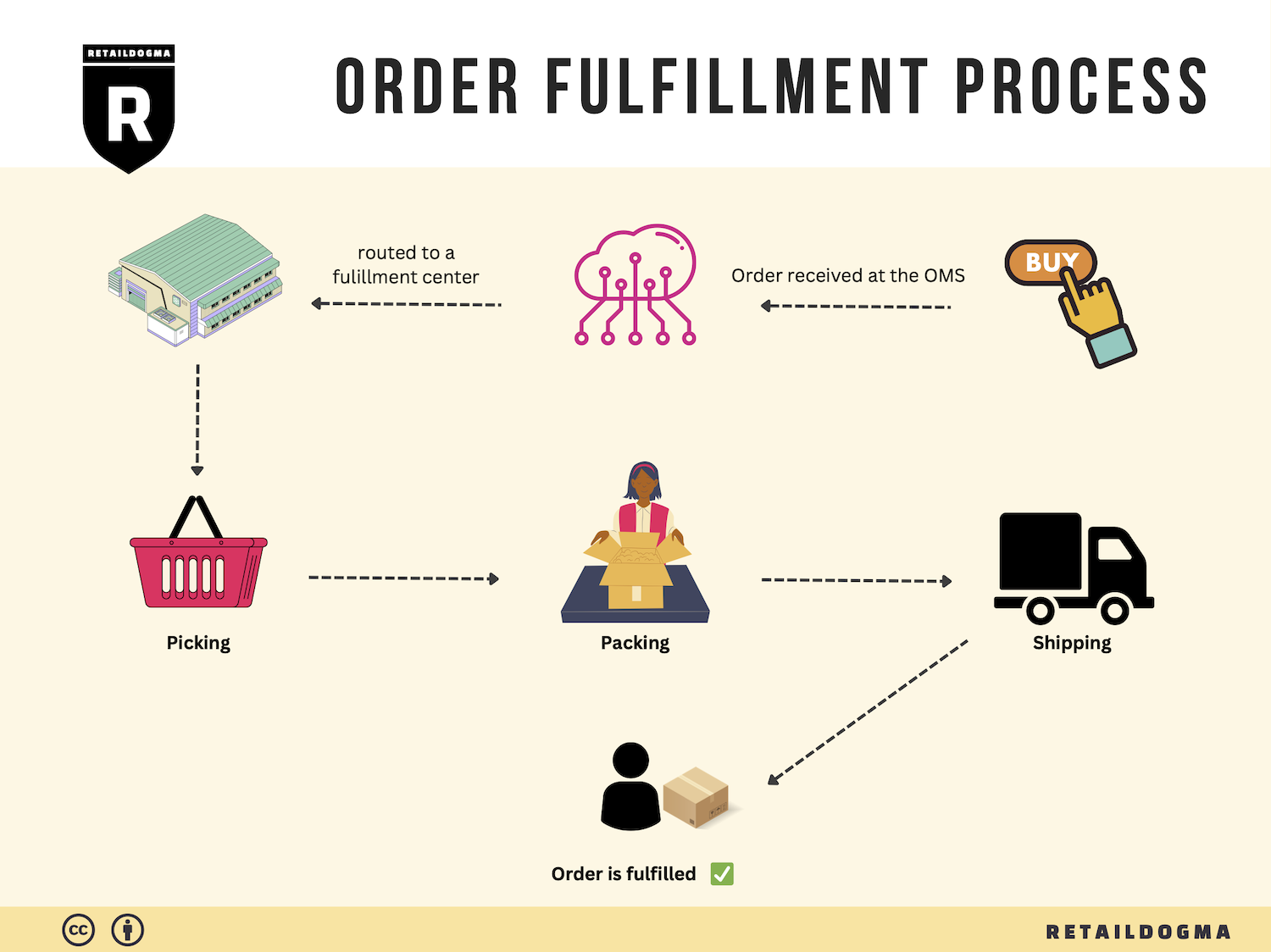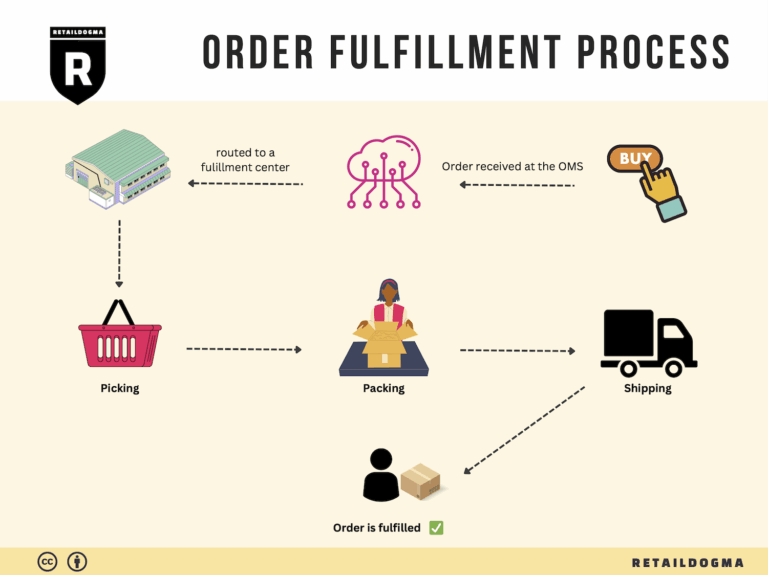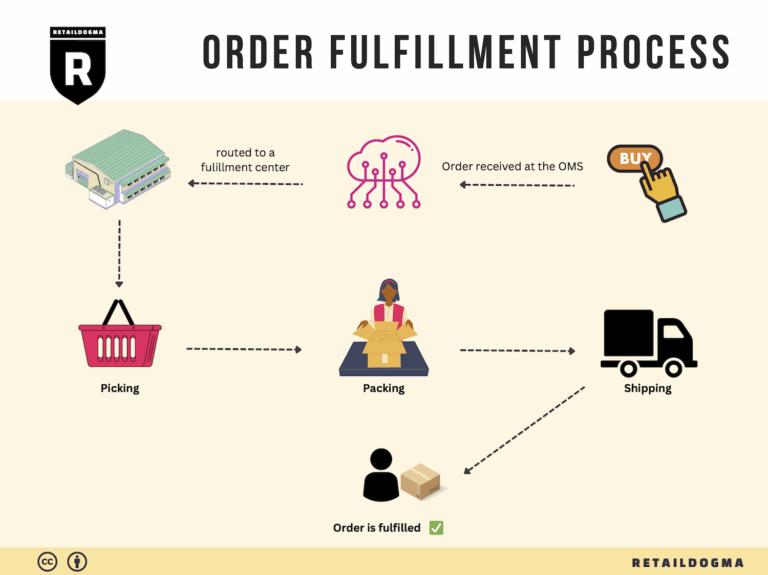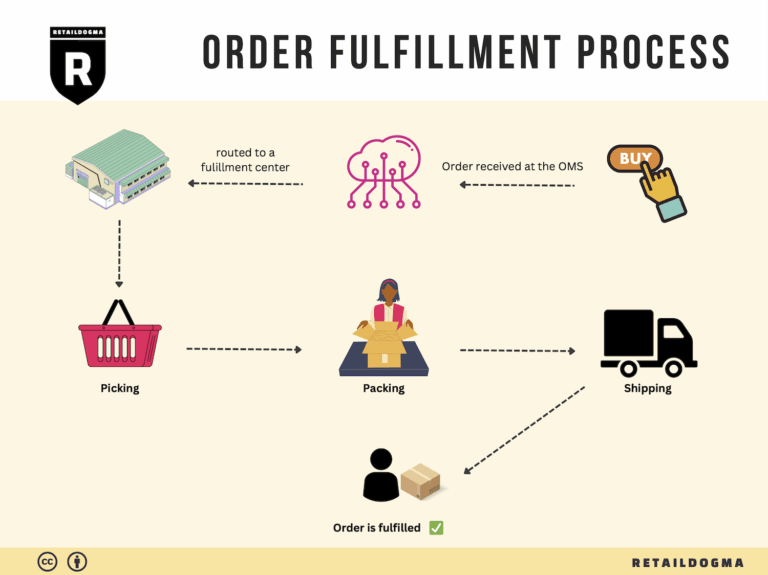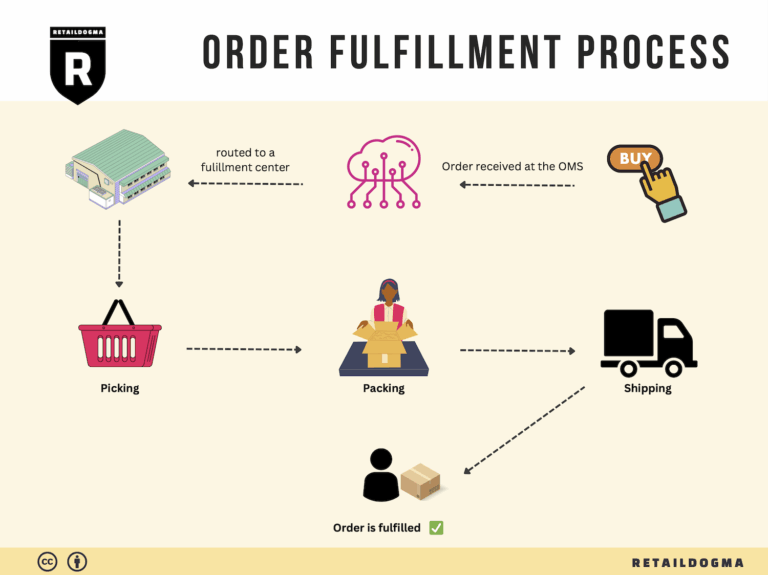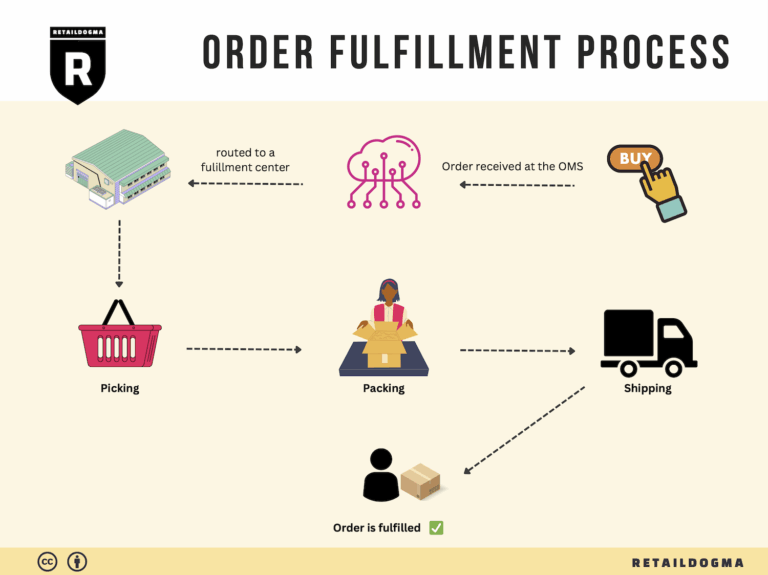Ecommerce Fulfillment Services: The Ultimate Guide (2025)
What is E-commerce Fulfillment? An Introduction for Growing Businesses
Understanding E-commerce Fulfillment
As an e-commerce business owner, you may find yourself grappling with the complexities of packing and shipping orders, often feeling overwhelmed by the demands of logistics. This is a common pain point for many growing online businesses. Efficient order fulfillment is crucial for maintaining customer satisfaction and scaling your operations. But what exactly does fulfillment entail? At its core, e-commerce fulfillment is the process of getting a product from your inventory to the hands of your customer. This involves a series of steps, including inventory management, order processing, packing, shipping, and handling returns.
In this guide, we will explore various fulfillment models that can support your business as it grows. We’ll cover Third-Party Logistics (3PL) providers, Fulfillment by Amazon (FBA), and other alternatives to help you understand which option aligns best with your operational needs. Each model has its unique advantages and challenges, and choosing the right one can significantly impact your efficiency and customer satisfaction.
Additionally, we will delve into the core services offered by fulfillment partners, such as inventory management, pick and pack services, shipping options, and customer service support. Understanding these services will allow you to assess what your business requires and how different providers can meet those needs.
Selecting the right fulfillment partner is a pivotal decision. In this guide, we will outline key factors to consider when evaluating potential partners, such as their compliance with retailer requirements, technology capabilities, and overall reliability. We will also discuss pricing structures, helping you navigate the costs associated with different fulfillment options and how they can fit within your budget.
Ultimately, our goal is to empower you to make informed decisions about your logistics strategy. By understanding the intricacies of e-commerce fulfillment, you will be better equipped to streamline your operations, improve customer satisfaction, and position your business for growth. Whether you’re just starting or looking to scale your existing operations, this guide will serve as a valuable resource in your journey toward fulfillment excellence.
What You’ll Learn In This Guide
- What is E-commerce Fulfillment? An Introduction for Growing Businesses
- The Order Fulfillment Process: From ‘Buy’ Button to Customer’s Door
- Comparing Fulfillment Models: In-House vs. 3PL vs. Dropshipping
- A Deep Dive into Amazon FBA: Pros, Cons, and Who It’s For
- Core Services Offered by Fulfillment Centers
- How to Choose a Fulfillment Partner: A 6-Point Checklist
- Understanding Fulfillment Pricing: A Breakdown of Common Fees
- Frequently Asked Questions (FAQs) about Fulfillment
- Conclusion: Is Outsourcing Fulfillment the Right Move for Your Business?
- Important Disclaimer
The Order Fulfillment Process: From ‘Buy’ Button to Customer’s Door
1. Receiving Inventory
The order fulfillment process begins with receiving inventory into the fulfillment center. This step is crucial as it sets the foundation for the entire logistics operation. During this phase, products are unloaded from incoming shipments and checked against purchase orders to ensure accuracy and quality. Key terms associated with this step include SKU (Stock Keeping Unit), which is a unique identifier for each product, enabling efficient tracking and management.
Effective receiving practices are essential to minimize errors and streamline subsequent processes. For e-commerce businesses, maintaining a strict adherence to inventory accuracy is vital; discrepancies at this stage can lead to stockouts or overstock situations, negatively impacting customer satisfaction and operational efficiency.
2. Warehouse Storage
Once the inventory is received, it is placed into storage within the warehouse. This step involves organizing products in a manner that maximizes efficiency and accessibility. Businesses often utilize warehouse management systems (WMS) to determine optimal storage locations based on factors such as product size, demand, and turnover rates.
The importance of this step cannot be overstated. Proper warehouse storage ensures that products are easy to locate and retrieve during the order picking process. Efficient storage strategies, such as utilizing vertical space and grouping similar items, can significantly reduce picking times and operational costs. Additionally, a well-organized warehouse contributes to maintaining product integrity and minimizing damage.
3. Order Picking
The next step in the order fulfillment process is order picking, where items are selected from the warehouse to fulfill customer orders. This is a critical stage that directly affects customer satisfaction, as timely and accurate order picking ensures that customers receive the correct items without delay. A common tool used in this phase is the pick list, which details the items and quantities needed for each order.
Effective picking strategies, such as batch picking (where multiple orders are picked simultaneously) or zone picking (where pickers are assigned specific areas of the warehouse), can enhance efficiency. Implementing these strategies can lead to faster order processing times and a reduction in labor costs. The goal is to streamline the picking process while maintaining high accuracy to reduce the risk of returns and customer complaints.
4. Order Packing
Once the items are picked, they proceed to the packing stage. Packing involves securely placing the selected items into shipping boxes or envelopes, ensuring they are protected during transit. This step is vital for reducing damage and ensuring that products arrive in excellent condition. Key terms associated with this process include packing slips, which are documents included in shipments that outline the items contained within.
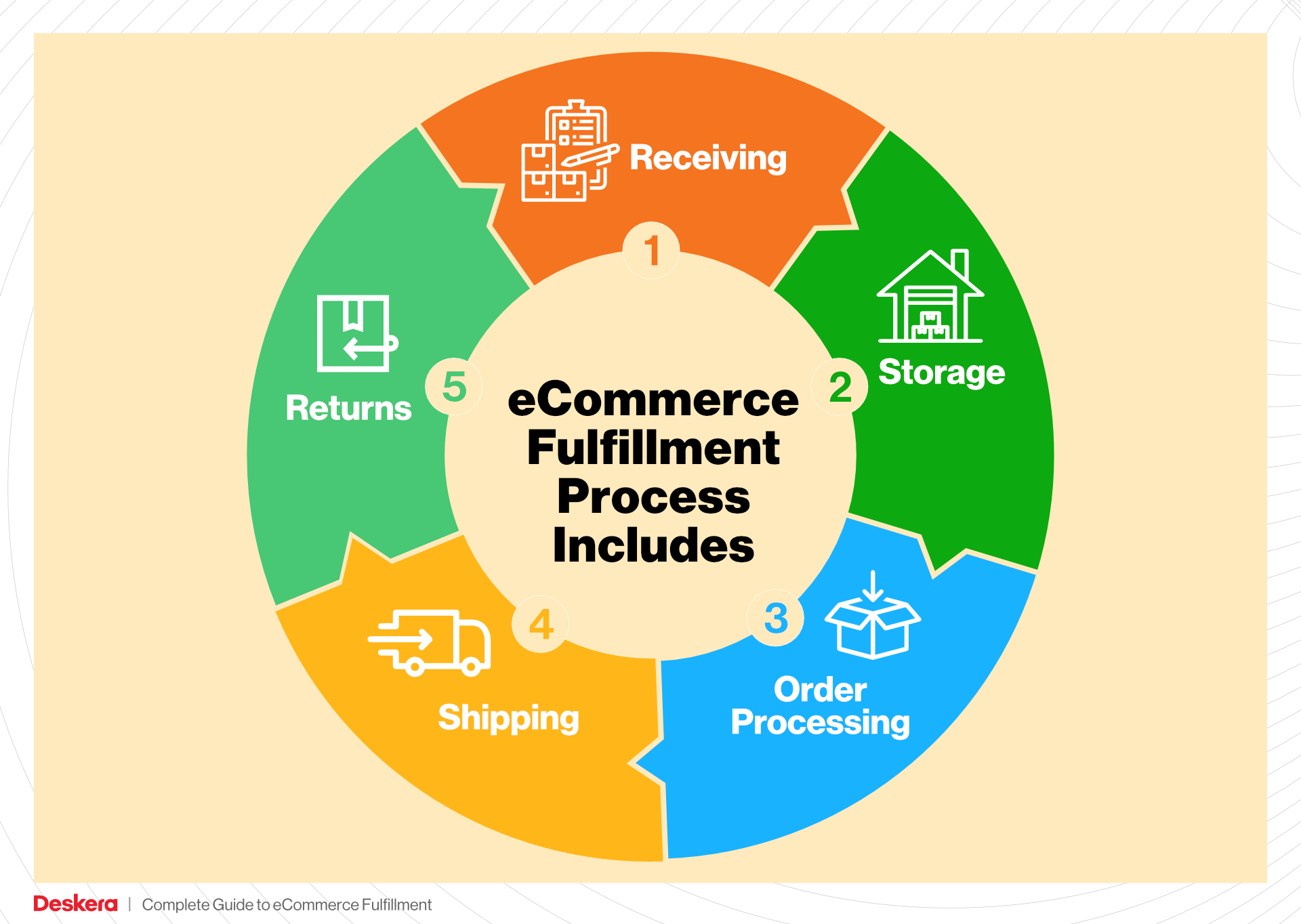
Packing is not just about functionality; it also presents an opportunity to enhance the customer experience. Businesses can use branded packaging or include promotional materials to make the unboxing experience memorable. Efficient packing processes can also optimize shipping costs by minimizing excess weight and dimensions, which can lead to reduced freight charges.
5. Shipping & Delivery
The final step in the order fulfillment process is shipping and delivery. Once the order is packed, it is labeled and handed over to a carrier for transportation to the customer. This stage is critical as it directly influences the delivery speed and overall customer satisfaction. Key terms here include shipping methods, which can range from standard ground shipping to expedited options, depending on customer preferences and budget.
Timely shipping is essential, particularly in the competitive e-commerce landscape where customers expect fast delivery. Businesses should consider leveraging various shipping carriers and methods to provide flexible options for customers. Additionally, tracking systems should be implemented to provide customers with real-time updates on their order status. Ensuring that orders are delivered on time and in good condition fosters customer loyalty and repeat business, which are key drivers for scaling e-commerce operations.
By understanding and optimizing each step of the order fulfillment process, e-commerce business owners can enhance operational efficiency, improve customer satisfaction, and ultimately drive growth in their sales and logistics.
Comparing Fulfillment Models: In-House vs. 3PL vs. Dropshipping
Fulfillment Model Comparison
| Model | Who Handles Inventory | Best For (Business Stage) | Key Advantage | Key Disadvantage |
|---|---|---|---|---|
| In-House Fulfillment | The business itself | Established brands with stable demand | Full control over inventory and operations | High overhead costs and resource-intensive |
| Third-Party Logistics (3PL) | A third-party logistics provider | Growing businesses and startups | Scalability and access to expertise | Less control over fulfillment processes |
| Dropshipping | Suppliers or manufacturers | New businesses with limited capital | Low startup costs and no inventory risk | Lower profit margins and potential supplier issues |
In-House Fulfillment
In-house fulfillment involves managing the entire logistics process within the company. This model is typically adopted by established brands that have a steady demand for their products and the resources to handle warehousing, packing, and shipping operations. The primary advantage of in-house fulfillment is the control it affords businesses. Companies can dictate every aspect of the process, from inventory management to shipping times, allowing for a tailored customer experience. This model is particularly beneficial for brands that require strict compliance with quality standards or specific shipping protocols, as they can ensure adherence without relying on external partners.
However, the in-house model comes with significant disadvantages. It often entails high overhead costs related to warehousing, staffing, and technology investments. As a result, businesses may find it challenging to scale quickly in response to market demands or seasonal fluctuations. The resource-intensive nature of in-house fulfillment can divert focus from core business activities, such as product development and marketing, potentially stifling growth.
Third-Party Logistics (3PL)
Third-party logistics (3PL) providers handle various aspects of fulfillment on behalf of businesses. This model is ideal for growing companies and startups looking to scale efficiently without the burden of managing logistics internally. By partnering with a 3PL, businesses gain access to a wealth of expertise and advanced technology that can optimize supply chain operations. The key advantage of using a 3PL is scalability; as order volumes increase or decrease, businesses can adjust their usage of the 3PL’s services accordingly, avoiding the costs associated with maintaining excess inventory or infrastructure.
Despite these benefits, relying on a 3PL does come with trade-offs. Businesses relinquish a degree of control over their fulfillment processes, which can lead to inconsistencies in service quality if the 3PL does not meet expectations. Additionally, businesses must ensure that their chosen 3PL provider aligns with their specific operational needs and compliance requirements. For example, if shipping to retailers like Nordstrom, it is crucial to partner with a 3PL that understands and adheres to stringent routing guides and labeling requirements.
Dropshipping
Dropshipping is a fulfillment model where retailers sell products without holding inventory themselves. Instead, when a customer places an order, the retailer purchases the item from a third party, who then ships it directly to the customer. This model is particularly attractive to new businesses with limited capital, as it allows them to enter the market without significant upfront investments in inventory.
The primary advantage of dropshipping is its low startup costs and minimal financial risk, as retailers are not required to purchase products until they are sold. This flexibility allows entrepreneurs to experiment with different products and niches without the burden of inventory management. However, dropshipping also has its drawbacks. Profit margins can be significantly lower than other models due to reliance on third-party suppliers, and retailers have less control over shipping times and product quality. Additionally, potential issues with suppliers, such as stock shortages or shipping delays, can negatively impact customer satisfaction and brand reputation.
Conclusion
Choosing the right fulfillment model is critical for e-commerce businesses aiming to scale effectively. Each model—In-House, 3PL, and Dropshipping—offers distinct advantages and challenges that must be carefully weighed against the company’s operational needs, growth stage, and long-term strategy. For established brands, in-house fulfillment may provide the control necessary for maintaining high standards. In contrast, growing businesses might find that partnering with a 3PL offers the scalability and expertise they need to thrive. Meanwhile, startups may benefit from the low-risk entry that dropshipping provides, despite its potential pitfalls. Ultimately, the decision should align with the overall business strategy and customer experience goals.
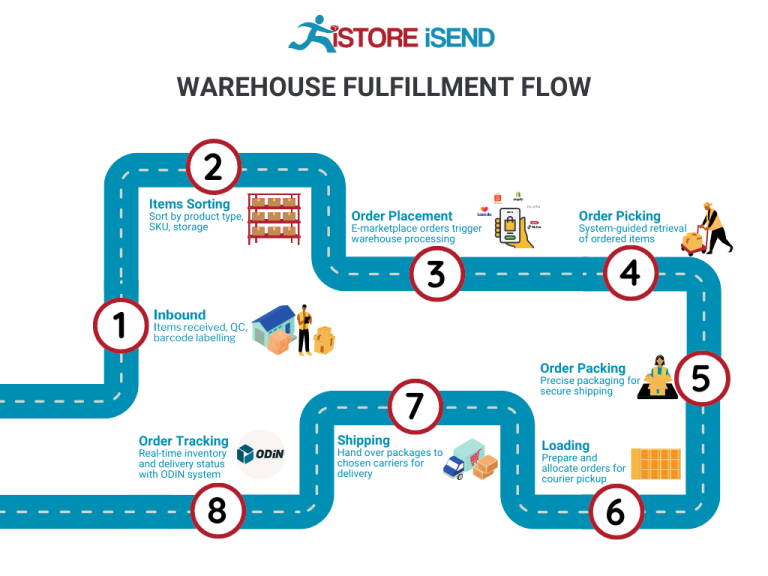
A Deep Dive into Amazon FBA: Pros, Cons, and Who It’s For
Understanding Fulfillment by Amazon (FBA)
Fulfillment by Amazon (FBA) is a service provided by Amazon that allows e-commerce sellers to store their products in Amazon’s fulfillment centers. With FBA, Amazon takes care of storage, packaging, and shipping on behalf of the sellers. This service is particularly appealing for small to medium-sized businesses looking to scale their operations without the overhead of managing logistics.
When a customer orders a product, Amazon handles the entire process—from picking and packing the item to shipping it directly to the customer. Sellers benefit from Amazon’s extensive logistics network, allowing for faster delivery times and better customer service. In addition, products fulfilled through FBA are eligible for Amazon Prime, enhancing visibility and sales potential.
How FBA Works
-
Set Up an Amazon Seller Account: To use FBA, sellers must first create an Amazon Seller account. Once registered, they can list their products on the platform.
-
Prepare Products for Shipment: Sellers prepare their products according to Amazon’s guidelines, which include labeling and packaging requirements.
-
Ship Products to Amazon: Sellers send their inventory to one or more of Amazon’s fulfillment centers. Amazon will provide shipping labels and guidelines to ensure compliance with their requirements.
-
Storage in Amazon’s Warehouses: Once received, products are stored in Amazon’s warehouses until they are sold.
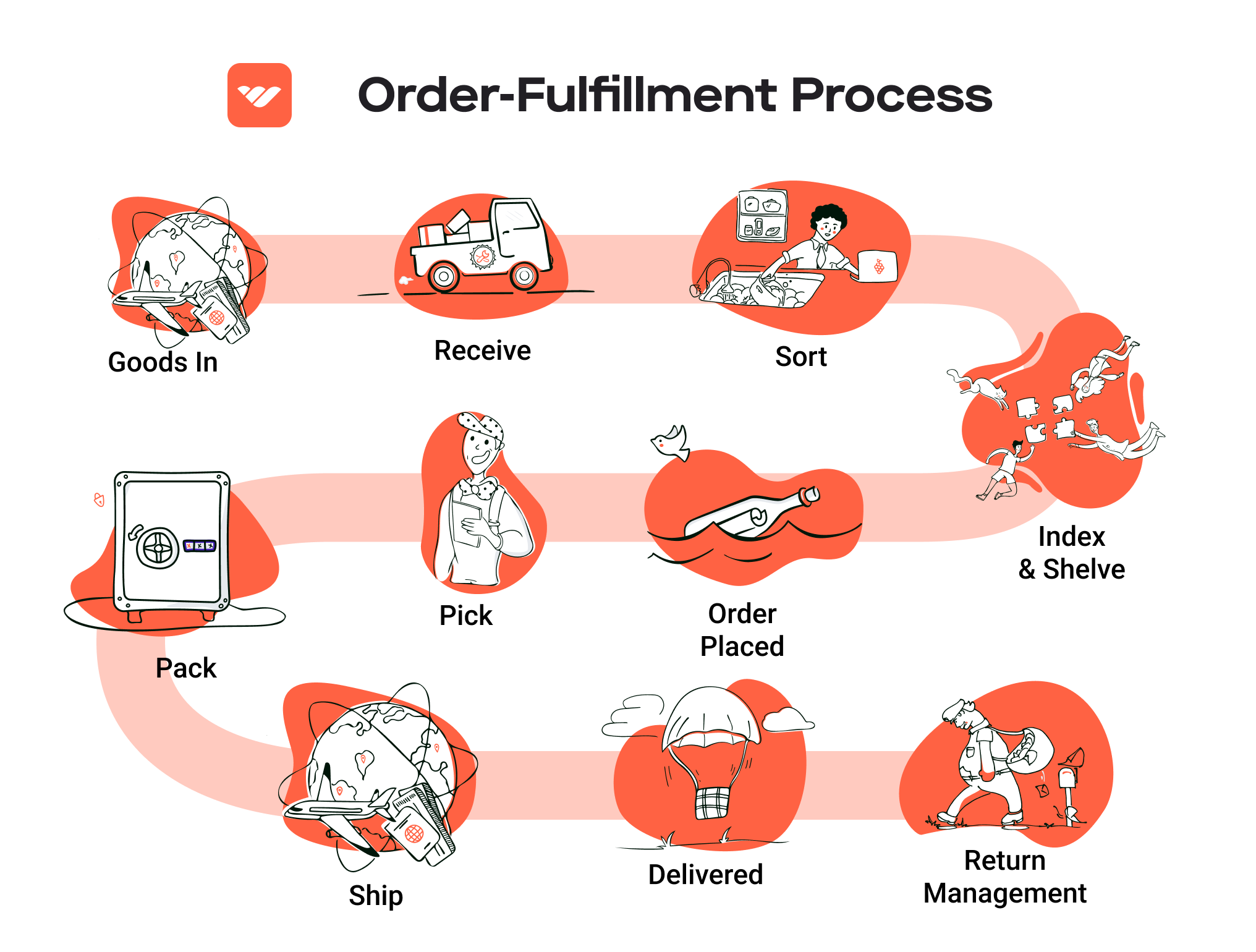
-
Order Processing: When a customer places an order, Amazon picks, packs, and ships the product directly to the customer.
-
Customer Service and Returns: Amazon also handles customer service and returns for FBA products, providing a seamless experience for both sellers and buyers.
Pros of FBA
1. Prime Eligibility
Products fulfilled through FBA are automatically eligible for Amazon Prime. This status increases the likelihood of sales, as Prime members often prefer products that offer free and fast shipping.
2. Customer Trust
Amazon is a trusted name in e-commerce. By using FBA, sellers can leverage Amazon’s reputation for reliability and customer service. This trust can translate into higher conversion rates and repeat customers.
3. Multi-Channel Fulfillment
FBA allows sellers to fulfill orders not just from Amazon but from other platforms as well, such as their own e-commerce websites. This multi-channel fulfillment capability simplifies logistics and inventory management.
4. Simplified Logistics
FBA handles all aspects of storage, packaging, and shipping. This allows sellers to focus on other critical areas of their business, such as marketing and product development.
5. Access to Advanced Tools
Sellers using FBA have access to Amazon’s advanced analytics and reporting tools. These insights can help businesses optimize their inventory and sales strategies.
Cons of FBA
1. High Fees
While FBA offers many benefits, it comes with a cost. Sellers must pay for storage, fulfillment, and other fees, which can eat into profit margins. It’s essential for businesses to carefully calculate these costs before deciding to use FBA.
2. Strict Inventory Rules
Amazon has strict inventory management policies, including guidelines on storage limits and product condition. Sellers must adhere to these rules to avoid penalties, which can be challenging for those with varying product lines.
3. Commingling Risks
FBA products are often commingled, meaning that items from different sellers may be mixed together in Amazon’s inventory. This can pose risks if products are damaged or if there are quality control issues, as sellers might receive negative feedback for issues beyond their control.
4. Limited Control Over Branding
FBA sellers have limited control over how their products are presented to customers. Amazon manages packaging and branding, which can dilute a seller’s unique brand identity.
5. Inventory Management Challenges
While FBA simplifies logistics, managing inventory levels can be complex. Sellers need to keep track of stock levels at Amazon’s warehouses and ensure timely replenishment to avoid stockouts or excess storage fees.
Who is FBA Best For?
Fulfillment by Amazon is best suited for:
-
Small to Medium-Sized Businesses: Companies that lack the resources to manage their own logistics and want to leverage Amazon’s infrastructure.
-
Brands Seeking to Scale: Businesses looking to rapidly scale their operations can benefit from FBA’s extensive reach and capabilities.
-
Sellers with High Sales Volume: Those who can consistently sell large quantities of products may find the fees associated with FBA more manageable.
-
E-commerce Entrepreneurs: New sellers who want to enter the market without the logistical burdens can take advantage of FBA’s comprehensive services.
-
Multi-Channel Sellers: Brands that sell on multiple platforms and want to streamline their fulfillment process will find FBA’s multi-channel capabilities beneficial.
In conclusion, while FBA presents an excellent opportunity for scaling e-commerce operations, it’s crucial for business owners to weigh the pros and cons carefully. Understanding the intricacies of Amazon’s fulfillment service can empower sellers to make informed decisions that align with their growth strategies.
Core Services Offered by Fulfillment Centers
Inventory Management & Warehousing
Inventory management and warehousing are foundational services provided by fulfillment centers. This involves the systematic handling of stock—ranging from receiving goods, storing them efficiently, tracking inventory levels, and ensuring proper rotation of products to prevent obsolescence. Fulfillment centers utilize advanced Warehouse Management Systems (WMS) that provide real-time visibility into inventory, allowing e-commerce businesses to monitor stock levels across multiple sales channels.
The benefits of robust inventory management are manifold. First, it enhances accuracy in order fulfillment, significantly reducing the risk of stockouts or overstock situations. This is crucial for maintaining customer satisfaction, as e-commerce businesses must meet consumer expectations for fast and reliable delivery. Furthermore, effective inventory management helps businesses optimize their working capital by ensuring that funds are not tied up in excess inventory. By leveraging fulfillment centers’ expertise in inventory management, e-commerce companies can focus on growth strategies rather than the intricacies of stock control.
Pick and Pack Services
Pick and pack services are essential components of the fulfillment process. This service involves selecting (picking) the ordered items from the warehouse and preparing (packing) them for shipment. Fulfillment centers employ efficient picking methods, such as batch picking or zone picking, which streamline the process and minimize errors. After picking, items are carefully packed to prevent damage during transit, ensuring that they arrive in pristine condition.
The primary benefit of utilizing pick and pack services is the efficiency it brings to order fulfillment. For e-commerce businesses, especially those experiencing growth or seasonal spikes in demand, the speed and accuracy of order processing can significantly impact customer satisfaction. Fast and accurate fulfillment leads to higher repeat purchases and brand loyalty. Additionally, outsourcing this function allows businesses to scale operations without the need for additional in-house resources, thus saving on labor and overhead costs.
Kitting and Assembly
Kitting and assembly services involve combining multiple products into a single package or kit, which can be particularly beneficial for promotional items, gift sets, or product bundles. Fulfillment centers can manage the entire process, from assembling products to packaging them attractively for retail or direct-to-consumer sales. This service often includes custom labeling and barcoding to meet specific retail requirements.
The benefits of kitting and assembly services are significant for e-commerce businesses looking to enhance their product offerings. By offering bundled products, companies can increase average order value and improve the customer shopping experience. Moreover, kitting allows businesses to differentiate themselves in a crowded market, providing unique offerings that can attract new customers. The efficiency of having a fulfillment center handle these tasks also frees up internal resources, allowing companies to focus on core business functions such as marketing and sales.
Returns Management (Reverse Logistics)
Returns management, or reverse logistics, is the process of handling returned products efficiently. Fulfillment centers provide essential services for managing returns, which include receiving returned items, inspecting their condition, restocking them if they are sellable, and managing any necessary refurbishments or disposals. This service can also involve processing refunds or exchanges, ensuring a seamless experience for customers.
For e-commerce businesses, efficient returns management is critical for maintaining customer satisfaction and brand loyalty. A streamlined returns process can reduce the friction often associated with online shopping, encouraging customers to make purchases with confidence. Additionally, effective reverse logistics can minimize losses from returned goods and help businesses understand customer behavior better, allowing them to refine their product offerings and improve overall sales strategies. By utilizing fulfillment centers for returns management, businesses can turn what is often perceived as a negative aspect of e-commerce into an opportunity for improved customer service and operational efficiency.
Conclusion
In conclusion, partnering with a fulfillment center provides e-commerce businesses with a range of core services that can significantly enhance their operational efficiency and customer satisfaction. From robust inventory management to efficient pick and pack services, kitting and assembly, and streamlined returns management, these services allow businesses to scale effectively while focusing on growth and customer engagement. By leveraging the expertise and technology of fulfillment centers, e-commerce businesses can navigate the complexities of logistics and deliver exceptional service to their customers.
How to Choose a Fulfillment Partner: A 6-Point Checklist
Location & Warehouse Network
Importance: The geographic location of a fulfillment partner can significantly impact shipping costs and delivery times. A strategically located warehouse network allows for faster delivery to your customer base, which is crucial in today’s competitive e-commerce landscape.
Questions to Ask:
– Where are your warehouses located, and how do they align with my customer demographics?
– What is your shipping range, and how do you handle last-mile delivery?
– Can you provide insights into your shipping times for different regions, especially if I have a significant customer base on the East Coast?
Technology & Integrations
Importance: In today’s digital age, a fulfillment partner’s technology infrastructure is a critical factor. Efficient order management, inventory tracking, and seamless integration with your e-commerce platform can streamline operations and reduce errors.
Questions to Ask:
– What systems do you use for inventory management, and how do they integrate with platforms like Shopify, WooCommerce, or Magento?
– Do you offer real-time tracking for orders and inventory levels?
– How do you handle updates or changes in inventory, and how will I be notified?
Specializations (e.g., cold storage, oversized items)
Importance: Depending on your product type, you may need a fulfillment partner with specific capabilities. For instance, businesses selling perishables require cold storage, while those dealing with bulky items need expertise in handling and shipping large packages.
Questions to Ask:
– What types of products do you specialize in handling?
– Do you have the necessary facilities for specific needs, such as climate control for perishables or equipment for oversized items?
– Can you provide examples of how you have successfully fulfilled orders for businesses with similar product types?
Scalability & Capacity
Importance: As your business grows, your fulfillment needs will change. It’s essential to partner with a fulfillment provider that can scale its operations to meet increasing demand without compromising service quality.
Questions to Ask:
– How quickly can you scale your operations during peak seasons or unexpected demand spikes?
– What is your current capacity for handling orders, and how do you foresee this changing in the next few years?
– Can you provide a case study or example of how you have scaled for a previous client?
Pricing and Contracts
Importance: Understanding the pricing structure and contract terms of a fulfillment partner is crucial to maintaining profitability. Hidden fees or unfavorable contract terms can significantly impact your bottom line.
Questions to Ask:
– Can you provide a detailed breakdown of your pricing model, including any additional fees for services like storage, packing, or returns?
– What are the terms of your contract, and is there flexibility for adjustments based on changing needs?
– Are there penalties for early termination, and how do you handle price increases?
Customer Support & Reviews
Importance: Strong customer support is vital for resolving issues that may arise during the fulfillment process. Additionally, checking reviews can provide insight into the partner’s reliability and service quality.
Questions to Ask:
– What level of customer support do you provide, and how can I reach you if issues arise?
– Do you have dedicated account managers for my business?
– Can you share testimonials or case studies from other clients, particularly those in similar industries?
Conclusion
Choosing the right fulfillment partner is a pivotal decision that can influence your e-commerce business’s success. By carefully considering the factors outlined in this checklist and asking the right questions, you can ensure that you select a partner that aligns with your operational needs and growth ambitions. Remember, a strong fulfillment partner does not just meet your logistical needs; they are a vital extension of your brand and customer experience.
Understanding Fulfillment Pricing: A Breakdown of Common Fees
Initial Setup Fees
Initial setup fees are often charged by fulfillment centers to cover the costs associated with onboarding a new client. These fees can vary significantly based on the complexity of the client’s requirements, the number of SKUs (Stock Keeping Units) involved, and the level of customization needed in the fulfillment process.
Typically, these fees may include:
- Account Setup: Creating your account in their system, which may involve inputting product information, shipping details, and payment methods.
- Integration Costs: If you’re using an e-commerce platform (like Shopify or WooCommerce), integration with the fulfillment center’s system can incur additional costs, especially if custom API work is required.
- Training Fees: Some fulfillment centers charge for training your staff on how to use their systems or processes effectively.
When evaluating initial setup fees, it’s crucial to ask for a detailed breakdown to understand what services are included and ensure there are no hidden costs.
Receiving Fees
Receiving fees are charged for the process of accepting and processing incoming inventory. These fees typically cover the labor and equipment costs associated with unloading, inspecting, and putting away stock in the warehouse.
The calculation of receiving fees can vary based on:
- Volume of Inventory: Often calculated per pallet or per item, higher volumes may lead to discounted rates.
- Complexity of Receiving: If your products require special handling or inspection, additional charges may apply.
- Time Sensitivity: If inventory needs to be processed quickly due to seasonal demands or urgent replenishments, expedited receiving fees may be incurred.
It’s advisable to clarify with the fulfillment center how they define receiving and what specific services are included in their fees.
Storage Fees (per pallet/bin)
Storage fees are charged for the space your inventory occupies in the fulfillment center. These fees can be assessed on a per-pallet or per-bin basis, depending on how the warehouse is organized.
Factors influencing storage fees include:
- Duration of Storage: Fees are typically calculated monthly, with some centers offering discounts for longer-term storage commitments.
- Type of Product: Certain products may require specialized storage conditions, which can increase costs (e.g., temperature-controlled items).
- Inventory Turnover Rates: Fulfillment centers may charge higher fees for slow-moving inventory, encouraging businesses to maintain optimal stock levels.
To optimize storage costs, monitor your inventory turnover closely and discuss flexible storage solutions with your fulfillment partner.
Pick & Pack Fees (per item/order)
Pick and pack fees are charged for the process of selecting items from inventory and preparing them for shipment. This is a critical aspect of fulfillment, as it directly affects shipping speed and accuracy.
These fees can vary based on:
- Number of Items per Order: Most fulfillment centers charge a base fee for picking an order and an additional fee for each item picked.
- Complexity of the Pick: If your orders involve multiple SKUs, or if special packing materials are required, the fees may increase.
- Customization Requirements: If orders require special labeling or kitting, additional fees may apply.
Understanding the pick and pack fee structure is essential for budgeting and ensuring competitive pricing for your customers.
Shipping Fees
Shipping fees are often the most variable aspect of fulfillment pricing and can significantly impact overall costs. These fees depend on various factors:
- Shipping Method: Costs vary based on the carrier (UPS, FedEx, USPS, etc.) and the service level (standard, expedited, overnight).
- Destination: Shipping costs are influenced by the distance from the fulfillment center to the destination, with higher costs for longer distances.
- Package Dimensions and Weight: Shipping fees are also calculated based on dimensional weight, which takes into account the size of the package rather than just its weight.
When evaluating shipping fees, consider negotiating rates with fulfillment centers that have established relationships with carriers, as they may pass on volume discounts.
Tips for Getting an Accurate Quote
-
Provide Detailed Information: When requesting quotes, offer specific details about your business, including order volumes, product types, and any special requirements. This helps fulfillment centers provide tailored pricing.
-
Request a Breakdown of Fees: Ask for a detailed breakdown of all potential fees, including setup, receiving, storage, pick and pack, and shipping. This transparency will help you avoid unexpected costs.
-
Compare Multiple Providers: Don’t settle for the first quote you receive. Comparing several fulfillment centers can help you understand the market rates and identify the best value for your needs.
-
Inquire About Volume Discounts: If you anticipate growth, ask about volume discounts or flexible pricing structures that accommodate scaling operations.
-
Factor in Additional Services: Consider any additional services you may require, such as returns processing or customer service support, and ensure these are included in your quote.
By being thorough in your inquiries and understanding the various components of fulfillment pricing, you can make informed decisions that support your business’s growth and efficiency.
Frequently Asked Questions (FAQs) about Fulfillment
1. What is the Nordstrom East Coast Fulfillment Center?
The Nordstrom East Coast Fulfillment Center, located in Elizabethtown, Pennsylvania, is a state-of-the-art facility designed to streamline the processing and shipping of online orders for customers primarily on the East Coast. This 672,000-square-foot center enhances Nordstrom’s ability to meet customer expectations for fast and efficient delivery, supporting orders made through Nordstrom.com, the mobile app, and catalog orders.
2. How does the East Coast Fulfillment Center improve delivery times?
By strategically positioning the fulfillment center on the East Coast, Nordstrom significantly reduces shipping distances and times for customers in that region. This facility allows for quicker processing of orders, enabling faster shipping options and improving overall customer satisfaction.
3. What types of services does the Nordstrom East Coast Fulfillment Center offer?
The center provides a range of services including order processing, inventory management, and shipping for Nordstrom’s online sales. It supports direct-to-consumer (D2C) orders and integrates with Nordstrom’s retail operations, ensuring a seamless experience for both the customer and the business.
4. What is the difference between a warehouse and a fulfillment center?
A warehouse primarily focuses on storing goods and inventory management, while a fulfillment center is specifically designed to handle the entire order fulfillment process. This includes receiving orders, picking and packing items, and shipping them directly to customers. Fulfillment centers are optimized for speed and efficiency in order processing.
5. What is a Third-Party Logistics Provider (3PL)?
A Third-Party Logistics Provider (3PL) is a company that offers outsourced logistics services, including warehousing, inventory management, order fulfillment, and transportation. 3PLs allow businesses to streamline their operations and focus on core activities by handling the complexities of logistics and supply chain management.
6. How do Nordstrom’s fulfillment services integrate with e-commerce platforms?
Nordstrom’s fulfillment services are designed to integrate seamlessly with various e-commerce platforms. This allows businesses to manage orders efficiently across multiple sales channels, ensuring accurate inventory tracking and timely order processing.
7. How much do fulfillment services cost?
The cost of fulfillment services can vary widely based on factors such as the volume of orders, the complexity of the fulfillment process, and the specific services required. Common pricing structures include per-order fees, storage fees, and shipping costs. Businesses should evaluate their needs and compare 3PL providers to find a cost-effective solution.
8. What are the hiring opportunities at the Nordstrom East Coast Fulfillment Center?
The fulfillment center initially provided nearly 400 full-time positions, with potential growth to over 700 full-time roles as the business expands. Seasonal and part-time roles are also available, supporting the center’s operational needs, particularly during peak seasons.
9. How does Nordstrom ensure compliance with retail requirements at their fulfillment center?
Nordstrom employs rigorous compliance measures at their fulfillment center, including adherence to strict routing guides, labeling requirements, and operational protocols. This ensures that all processes align with retail standards, facilitating smooth operations and minimizing errors.
10. What technology does Nordstrom use in their fulfillment processes?
Nordstrom utilizes advanced inventory management systems and warehouse management technologies to enhance visibility and efficiency in their fulfillment processes. These technologies allow for real-time tracking of inventory levels, order processing, and shipping logistics, ensuring a streamlined experience for both Nordstrom and its customers.
Conclusion: Is Outsourcing Fulfillment the Right Move for Your Business?
Assessing the Value of Outsourcing Fulfillment
Outsourcing fulfillment can be a game-changer for e-commerce businesses looking to scale. By leveraging the expertise of third-party logistics (3PL) providers, such as those that meet Nordstrom’s rigorous standards, you can save valuable time and resources. These specialists handle everything from inventory management to shipping logistics, allowing you to focus on core business activities like marketing, product development, and customer service.
One of the most significant benefits of partnering with a fulfillment service is scalability. As your business grows, so do your fulfillment needs. A competent 3PL can seamlessly accommodate fluctuations in order volume, whether due to seasonal spikes or successful marketing campaigns, ensuring that your customers receive their orders promptly. This flexibility can prevent the costly pitfalls of overextending your in-house capabilities.
Moreover, fulfillment partners bring a wealth of expertise that can enhance your operational efficiency. With established processes and technology tailored to meet compliance requirements—like those demanded by Nordstrom—these providers minimize errors and optimize shipping times. This operational excellence not only improves your customer satisfaction rates but also protects your brand’s reputation.
However, the success of outsourcing fulfillment hinges on selecting the right partner. Take the time to evaluate potential providers based on their capabilities, technology, and alignment with your business goals.
Take Action Now
To determine whether outsourcing fulfillment is the right move for your business, start by auditing your current shipping processes. Are you facing challenges in meeting customer expectations? Is your fulfillment operation stunting your growth? By reflecting on these questions, you can better assess if a fulfillment partner could be your next strategic step. The right partner will not only streamline your operations but also empower your business to reach new heights.
Important Disclaimer
⚠️ Important Disclaimer
The information in this guide is for educational purposes. Fulfillment services, pricing, and platform features change frequently. Always conduct your own due diligence and consult with providers directly before making business decisions.
